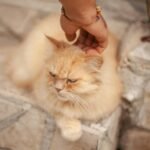Imagine walking into a room and seeing your cat sprawled belly-up, purring with pure bliss. It’s a sight that melts even the toughest hearts. But did you know that certain quirky, adorable, and even downright silly cat behaviors only show up in homes where cats feel truly safe and loved? These precious moments are like secret treasures, only revealed to those who have earned a cat’s deep trust. Let’s uncover the top 10 cat behaviors that blossom exclusively in emotionally safe homes—get ready, some of them might just surprise you!
Belly-Up Lounging Without a Care

When a cat flops onto its back and exposes its soft, vulnerable belly, it’s not just an invitation for a belly rub (though some cats tolerate it!). This is one of the ultimate signs of trust. In the wild, cats guard their stomachs fiercely, as this spot houses their vital organs. So when they lounge belly-up in your home, it means they feel utterly secure. You might catch them snoozing like this in the sun, stretching out in the middle of the living room, or even rolling over when you enter the room. It’s a behavior that whispers, “I know I’m safe here.” In emotionally safe homes, this pose becomes a regular sight, not merely a fleeting moment.
Slow Blinking: The Kitty Kiss

Have you ever noticed your cat looking at you with half-closed eyes, then slowly blinking? Some call this the “cat kiss.” It’s a silent message: “I trust you.” Cats don’t slow blink at just anyone; it’s reserved for those who have made them feel safe and cherished. In fact, you can try slow blinking back, and many cats will respond in kind, deepening your bond. This gentle gesture is rarely seen in anxious or fearful cats. In a secure home, slow blinking becomes a beautiful, everyday exchange—a language of love between human and feline.
Chirping and Chattering at the Window

Birds flutter by, and suddenly your cat starts chirping, chattering, or making strange little “ack-ack” sounds at the window. This behavior is more than just hunting instinct—it’s a sign your cat feels comfortable enough to express excitement and curiosity without fear. In homes where cats are anxious, these vocalizations are rare or muted. But in emotionally safe homes, cats confidently “talk” to the world, letting out their wild side with adorable, uninhibited enthusiasm. Watching a happy cat chatter at birds is a pure delight for any pet parent.
Kneading With Paws Like a Kitten

That rhythmic, dough-kneading motion your cat makes with their paws isn’t just cute—it’s a behavior rooted in kittenhood, when they kneaded their mother’s belly for milk. Adult cats only knead when they feel comfortable and safe. In emotionally secure homes, cats will knead on soft blankets, your lap, or even your chest, purring contentedly. It’s a bit like a child snuggling their favorite stuffed animal. If your cat kneads in your presence, consider it a high compliment—they see you as a source of comfort and warmth.
Playful Ambushes and Zoomies

Suddenly, your normally calm cat dashes through the house at top speed, ears back, tail puffed—then leaps out from behind furniture to pounce on a toy. These playful ambushes and “zoomies” are signs of a cat that feels safe to let loose. Only in a secure environment will a cat indulge in such uninhibited play. In emotionally safe homes, these hilarious bursts of energy are common, and cats often invite their humans to join the fun. It’s their way of celebrating life and showing trust in their environment.
Head Butting and Cheek Rubbing

When your cat bumps their head or rubs their cheeks against you, furniture, or even other pets, they’re marking their territory—and declaring, “You’re part of my family.” This behavior, called bunting, is reserved for trusted companions. Cats have scent glands on their heads and cheeks, and by rubbing, they share their scent and strengthen social bonds. In emotionally secure homes, cats will frequently headbutt their favorite people, signaling affection and mutual trust. It’s an intimate gesture, often accompanied by deep purring and a look of pure contentment.
Bringing You “Gifts” (Wanted or Not!)

If your cat presents you with a toy, a sock, or, in the case of outdoor cats, something a bit more “wild,” it’s a quirky sign of affection. In emotionally safe homes, cats feel confident enough to share their “treasures,” even if it’s just a crumpled piece of paper. They may drop these gifts at your feet, meow proudly, and look up for approval. While not every gift is glamorous, the meaning behind it is touching. Your cat sees you as family—a companion worth sharing their prized possessions with.
Sleeping on You or Near You

Cats are notoriously particular about their sleeping spots, often seeking out warm, quiet corners. But when they choose to nap directly on you, your pillow, or right by your side, it’s a clear sign of complete trust. Sleeping makes cats vulnerable, so they’ll only do it close to those they feel absolutely safe with. In emotionally secure homes, cats become little shadows, curling up beside you during naps or even burrowing under the covers. It’s their way of saying, “You’re my safe space.”
Vocalizing with a Variety of Sounds

Emotionally safe cats are chatty cats. They’ll meow, trill, chirrup, and purr with abandon, using a whole symphony of sounds to communicate. Each vocalization has its own meaning—some are requests, others are greetings, and some are simply to say, “I’m happy to be here.” In homes where cats feel anxious or threatened, vocalizations are often limited or tinged with distress. But in homes filled with love and security, cats sing their hearts out, letting their personalities shine through every meow and trill.
Grooming You and Other Pets

If your cat licks your hand, face, or even your hair, take it as a true sign that you’re part of their inner circle. This social grooming, called allogrooming, is a behavior normally reserved for bonded cats. In emotionally safe homes, cats extend this nurturing habit to their humans and sometimes even to dogs or other pets. It’s both a sign of affection and a way to reinforce social bonds. The feeling of a cat’s rough tongue on your skin might be surprising, but it’s really their way of saying, “You belong with me.”

Growing up traveling and experiencing new cultures and wonders, I have had a passion for nature, adventuring, photography, and videography. I am currently working towards a BSc in Biodiversity and Ecology at Stellenbosch University, and I hope to specialise in Marine Sciences one day.
Please send any feedback to Feedback@animalsaroundtheglobe.com






